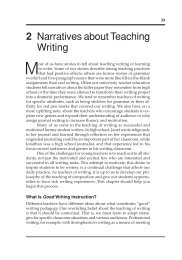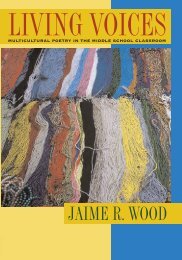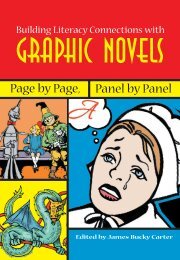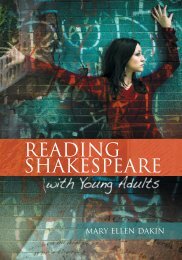View a Sample Chapter - National Council of Teachers of English
View a Sample Chapter - National Council of Teachers of English
View a Sample Chapter - National Council of Teachers of English
- No tags were found...
Create successful ePaper yourself
Turn your PDF publications into a flip-book with our unique Google optimized e-Paper software.
we put all the pieces together. At last the children had finished their airplaneresearch.The cardboard airport, our culminating project, sat on a very special shelfin our room, a daily reminder to all <strong>of</strong> us <strong>of</strong> the hard work and learning thathappened during our airplane project. Once again, as in the bug project, children’slearning was authentic, meaningful, and full <strong>of</strong> literacy experiences. Inboth projects, children were inspired by play that then served as an essentialprovocation for learning, providing energy that pushed our inquiries effectivelyinto readers and writers workshops.My work as a teacher-researcher, particularly the ongoing close observations<strong>of</strong> children and documentation <strong>of</strong> their talk, helped me build a detailed,data-based image <strong>of</strong> children as capable, curious, and active; to stay connectedwith their inquiry; and to see the relationships they were building (see Figure2.1). Teacher research enabled me to keep track <strong>of</strong> their learning and respondthoughtfully as the students reconstructed and integrated the curricular structures<strong>of</strong> project work and workshop through play.What I LearnedThrough this study, I learned a great deal about how children’s play influencesinquiry and the project work that grows from it, as well as how it can fuel bothreaders and writers workshop in authentic ways. In our bug project, children’splay led them to many literacy opportunities. Content-rich talk permeated theirplay, affording many possibilities for oral vocabulary development. As part <strong>of</strong>this play, the children were also continually using different objects to representsomething else, thereby practicing a concept foundational to literacy: one thingcan stand for another, like letters for sounds. Of course, the students also hadlots <strong>of</strong> experiences with written language: wide reading <strong>of</strong> nonfiction, construction<strong>of</strong> class webs and charts, labeling mailboxes and block buildings, writingthe Bug Food Restaurant menu and ABC chart, and endless writers workshoplittle books.My study supports the idea that play can be viewed as what our Italiancolleagues in Reggio Emilia call a “provocation”—something that inspireslearning. Playing with insects, building with blocks, creating the Bug Food Restaurant,and making paper airplanes led to more learning than I could ever haveimagined. In addition, this study shows that play can be a way in which childrenmeaningfully integrate the curricular structures <strong>of</strong> classroom life, in this caseproject work and readers and writers workshops.22 D Amanda Angle
















